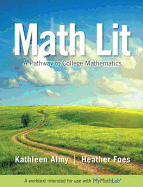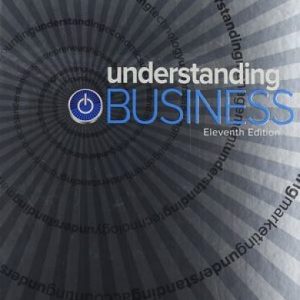Solutions Manual for Math Lit by Kathleen Almy 0321970292

Product details:
- ISBN-10 : 0321970292
- ISBN-13 : 978-0321970299
- Author: Kathleen Almy, Heather Foes
Math Lit, by Kathleen Almy and Heather Foes, provides a one-semester alternative to the traditional two-semester developmental algebra sequence for non-STEM (Science, Technology, Engineering, and Math) students. This new approach offers an accelerated pathway to college readiness through developmental math, allowing non-STEM students to move directly into liberal arts math or introductory statistics, while also preparing STEM students for intermediate algebra. Through its emphasis on contextual problem-solving, the Almy/Foes worktext and its accompanying MyMathLab® course help students understand and practice the major themes of numeracy, proportional reasoning, algebraic reasoning, and functions.
Table contents:
Self-Assessment: Preview
1.1 The BP Oil Spill: Focus Problem
1.2 Getting Started: Reviewing Prealgebra
- Use Venn diagrams
- Write equivalent fractions
- Add, subtract, multiply, and divide fractions
- Solve applied problems involving fractions
1.3 Hello, My Name Is: Graphing Points
- Plot ordered pairs
- Determine the coordinates of a point
1.4 A Tale of Two Numbers: Ratios and Proportions
- Interpret ratios
- Scale ratios to produce equivalent ratios
- Determine if quantities are proportional
Getting Ready for Section 1.5
1.5 Chances Are: Probability Basics
- Find relative frequencies
- Find and interpret experimental probabilities
1.6 It’s All Relative: Understanding Integers
- Interpret signed number situations
- Find the opposite and absolute value of a number
1.7 Sign and Size: Integer Operations
- Add, subtract, multiply, and divide signed numbers
- Solve applied problems that involve signed-number addition, subtraction, multiplication, and division
1.8 An Ounce of Prevention: Means
- Find and interpret the mean of a set of numbers
- Use means in applied problems
Mid-cycle recap
1.9 Picture This: Making and Interpreting Graphs
- Create and interpret pie graphs
- Create and interpret bar graphs
- Create and interpret line graphs
1.10 Two by Two: Scatterplots 79
- Create and interpret scatterplots
- Sketch a curve to best fit a scatterplot
Getting Ready for Section 1.11
1.11 Multiply vs. Divide: Converting Units
- Convert units by multiplying or dividing
1.12 Up and Down: Percent Change
- Apply a percent change
- Find percent change
- Interpret percent change
1.13 The X Factor: Algebraic Terminology
- Differentiate between variables and constants
- Differentiate between expressions and equations
- Differentiate between factors and terms
1.14 General Number: Recognizing Patterns
- Make conjectures and generalize patterns
- Identify and use arithmetic and geometric sequences
1.15 Social Network: Linear and Exponential Change
- Model change with linear and exponential functions
1.16 Infinity and Beyond: Perimeter and Area
- Calculate perimeter and area
Cycle 1 Study Sheet
Self-Assessment: Review
Cycle 1 Wrap-Up
CYCLE TWO How does that work?
Self-Assessment: Preview
2.1 Predicting a Child’s Height: Focus Problem
Getting Ready for Section 2.2
2.2 Rule of Thumb: Weighted Means
- Find and interpret weighted means
- Find the median and mode of a data set
2.3 Measure Up: Basic Exponent Rules
- Apply basic exponent rules
- Use geometric formulas
2.4 Count Up: Adding Polynomials
- Identify and add like terms
2.5 A Winning Formula: Applying Order of Operations
- Use the order of operations to simplify expressions
- Evaluate formulas and expressions
2.6 Does Order Matter: Rewriting Expressions
- Apply the commutative and associative properties
2.7 Fair Share: Distributive Property
- Apply the distributive property to expressions
- Use the distributive property in applied contexts
2.8 Seat Yourself: Equivalent Expressions
- Write an expression to represent a scenario
- Determine if two expressions are equivalent by using the commutative, associative, and distributive properties
2.9 Parts of Speech: Using Operations Correctly
- Distinguish between an operator and an object
- Determine the object on which an operator is acting
- Recognize when the distributive property can be applied
Mid-cycle recap
2.10 A Fine Balance: Verifying Solutions
- Verify a solution to an equation
2.11 Separate but Equal: Solving Simple Equations
- Write and solve one-step equations
2.12 A State of Equality: More Equation Solving
- Solve two-step and multi-step linear equations
2.13 Quarter Wing Night: Writing and Solving Equations
- Write an equation to model a situation
- Solve a problem numerically and algebraically
2.14 Outwit and Outlast: Using Proportions
- Write and solve proportions
2.15 Three of a Kind: Pythagorean Theorem
- Use the Pythagorean theorem to find the length of a side in a right triangle
- Solve problems using the Pythagorean theorem
Getting Ready for Section 2.16
2.16 What Are the Odds?: Theoretical Probability
- Calculate theoretical probabilities
- Compare theoretical and experimental probabilities
2.17 Size Up: Volume and Surface Area
- Calculate volume and surface area
Cycle 2 Study Sheet
Self-Assessment: Review
Cycle 2 Wrap-Up
CYCLE THREE When Is It Worth It?
Self-Assessment: Preview
3.1 Deciding to Run: Focus Problem
3.2 What’s Trending: Correlation
- Determine if data has a positive or negative linear correlation
- Graph the equation of the trendline
- Use the equation of the trendline to make predictions
3.3 Constant Change: Slope
- Find the slope of a line from points, tables, and graphs
- Interpret the slope as a rate of change
3.4 Shortest Path: Distance Formula
- Use the distance formula to find the distance between two points
3.58 More or Less: Linear Relationships
- Make comparisons using equations, tables, and graphs
3.6 Get in Line: Slope-Intercept Form
- Find and interpret the slope and y-intercept from a linear equation
- Graph a line using a table and using the slope and y-intercept
3.7 Chain, Chain, Chain: Writing Linear Equations
- Write the equation of a line using a point and the slope
- Write the equation of a line using two points
- Create a linear model in an applied problem
Getting Ready for Section 3.8
3.8 Going Viral: Exponential Functions
- Write the equation of an exponential function using a starting value and rate of change
- Model with exponential functions
- Graph exponential functions
Mid-cycle recap
CYCLE Three When Is It Worth It?
3.9 Untangling the Knot: Solving Nonlinear Equations
- Solve nonlinear equations
Getting Ready for Section 3.10
3.10 Hot and Cold: Rewriting Formulas
- Solve an equation for a specified variable
3.11 A Common Goal: Greatest Common Factors
- Factor an expression using the greatest common factor
3.12 Thinking Outside the Box: Factoring Quadratic Expressions
- Factor quadratic expressions
3.13 A Formula for Success: The Quadratic Formula
- Use the quadratic formula to solve equations
3.14 Systematic Thinking: Graphing and Substitution
- Solve a 2 * 2 linear system of equations by graphing
- Solve a 2 * 2 linear system of equations by substitution
3.15 Opposites Attract: Elimination
- Solve a 2 * 2 linear system of equations by elimination
3.16 The Turning Point: Quadratic Functions
- Identify a quadratic pattern in data
- Find the vertex of a parabola
Cycle 3 Study Sheet
Self-Assessment: Review
Cycle 3 Wrap-Up
CYCLE FOUR What Else Can We Do?
Self-Assessment: Preview
4.1 Measuring Temperature Variability: Focus Problem
4.2 A Matter of Change: Dimensional Analysis
- Convert units using dimensional analysis
Getting Ready for Section 4.3
4.3 Little Giants: Scientific and Engineering Notation
- Convert numbers between scientific and standard notation
- Convert numbers into and out of engineering notation
4.4 A Model Approach: Negative Exponents
- Use exponent rules to simplify expressions that have negative exponents
4.5 Variation on a Theme: Standard Deviation
- Find the standard deviation of a data set
- Interpret the standard deviation of a data set
4.6 An Order of Magnitude: Understanding Logarithmic Scales
- Interpret logarithmic scales
Mid-cycle recap
4.7 Straight to the Point: Direct Variation
- Identify direct variation from a graph, table, or equation
- Write models for direct variation problems
- Solve direct variation problems
Getting Ready for Section 4.8
4.8 Gas Up and Go: Inverse Variation
- Identify inverse variation from a table
- Write models for inverse variation problems
- Solve inverse variation problems
4.9 Ghost in the Machine: Function Notation
- Use function notation
- Find a function input or output given the other
4.10 What’s Your Function? Vertical Line Test, Domain, and Range
- Apply the vertical line test
- Find the domain and range from a graph
4.11 An Important Point: Vertex Form of a Quadratic Function
- Identify the vertex of a quadratic function
- Graph a quadratic function in vertex form
- Write the vertex form of a quadratic function
4.12 A Survey of Trig: Trigonometric Functions
- Write the six trigonometric ratios for an acute angle
- Use trigonometric functions to find the measures of sides and angles of a right triangle
Cycle 4 Study Sheet
Self-Assessment: Review
Cycle 4 Wrap-Up
Excel Appendix (online) EA-1
Answers (online) A-1
Index I-1
Applications Index
People also search:
math lit a pathway to college mathematics
math lit a pathway to college mathematics 3rd edition
|
kathleen almy |





